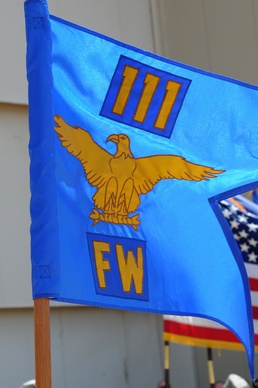
By Master Sgt. Christopher E. Botzum
111th Attack Wing Public Affairs Office
HORSHAM, Pa. - The former 111th Fighter Wing, now known as the 111th Attack Wing, held a redesignation ceremony on June 7 at the Horsham Air Guard Station, Pennsylvania, marking the 90th anniversary and renaming of the 103rd Fighter Squadron to the 103rd Attack Squadron.
“The 103rd is the second-oldest flying unit in the National Guard,” said wing commander, Col. Howard Eissler to a crowd of unit members, retirees, former commanders and pilots. “It’s the Airman in our unit that makes us great, not our mission.”
Maj. Gen. Wesley Craig, adjutant general of Pennsylvania, addressed the crowd and spoke of the importance of the day.
“We celebrate an anniversary as well as a birth of a new organization,” said Craig. “From the days of flying open-cockpit Jennys, we look forward to a new mission with ever-evolving technology,” Craig added speaking about the 103rd’s command center mission with the General Atomics MQ-9.
Formed June 27, 1924, the 103rd Observation Squadron was Pennsylvania’s first flying unit and is one of the oldest in the Air National Guard. The unit, originally under the Army’s 28th Division, Pennsylvania National Guard, first flew the JN-6/JNS Jenny from Model Farms Flying Field which later became Philadelphia International Airport. The 103rd was founded and first commanded by Maj. Charles J. Biddle, a WWI ace and Lafayette Flying Corps pilot.
The 103rd flew a wide variety of training and observation aircraft over the next two decades until 1941 when the unit was ordered to active service performing anti-submarine patrols along the New England Coast. In 1943, the 103rd flew photo reconnaissance missions in the F-5C within the China-Burma-India Theater. Also during this time, the 111th Bomb Group was flying ground attack missions in Europe against enemy forces in preparation for the Normandy Invasion and later during the Battle of the Bulge.
Following WWII, the 111th was allotted back to the Pennsylvania National Guard, absorbed the 103rd Bomb Squadron and flew B-26s. In April 1951, the 111th was activated for the Korean Conflict and flew the B-29 Superfortress and B-36 Peacekeeper. In 1953 the unit returned to the Pennsylvania Air National Guard and was designated as the 103rd Fighter Bomber Squadron flying the F-51 Mustang. Entering the jet age in 1955, the F-84 Thunderjet arrived, followed a year later by the F-94A/B/C Starfire, now designating the unit as a Fighter Interceptor Squadron. In 1959 the unit converted to the F-89J/H Scorpion conducting air defense alert operations the following year.
March 1963, now the 103rd Air Transport Squadron, relocated to Willow Grove Naval Air Station. In 1970 the unit mission was changed to forward air control and designated the 103rd Tactical Air Support Squadron equipped with the O-2A Super Skymaster, converted to the OA-37 Dragonfly in 1981 and to the A/OA-10 in 1988.
The unit converted to a close-air support mission in 1995, was designated the 103rd Fighter Squadron and deployed to Al Jaber Air Base, Kuwait, in support of Operation Southern Watch, and again in 1999. From Sept. 11, 2001, to September 2008 the 103rd deployed five times to Southwest Asia, falling under the 332nd Air Expeditionary Wing -- In 2001 to Al Jaber, 2002 to Bagram Air Field, Afghanistan, in support of Operation Enduring Freedom, 2003 to Al Jaber, and forward deployed to Talil Air Base, Iraq, in support of Operation Iraqi Freedom, 2007 to Al Asad Air Base, Iraq, again in support of Operation Iraqi Freedom and finally in 2008 back to Bagram in support of Operation Enduring Freedom.
Few units can boast origins flying observation missions in cloth-wing biplanes and a history that includes so many vital missions to Southwest Asia. The 103rd Fighter Squadron is now the 103rd Attack Squadron. The members will continue to build upon the proud legacy of the 103rd as they continue their transition to the MQ-9.